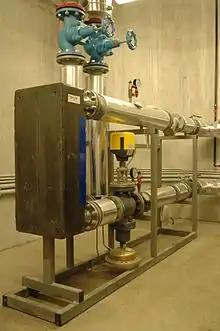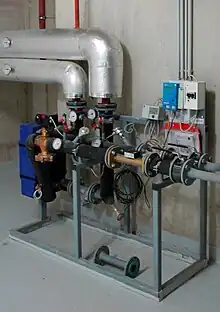District heating substation
A district heating substation is a component in a district heating system that connects the main network to a building's own heating system.[1][2] [3]

A district heating substation with a thermal capacity of 700 kW. This unit isolates the water circuit of the district heating system from the customer's central heating system.

A district heating substation in a residential neighborhood with a thermal capacity of 300 kW. Two components of the heat meter are visible: the metering electronics unit on the right (white/blue box), and the ultrasonic flow meter in the center (bronze tube).
The station normally has one or more of the following parts:
- Heat exchanger - to split primary and secondary side of the system
- Control valve - to regulate the flow through the heat exchanger
- Differential pressure controller - to balance the network and improve working conditions of control valve
- Strainer - to remove particles that could block heat exchanger or control valve
- Shut off valve - to stop the flow on primary side in case of service or emergency
- Heat meter - to measure energy consumption and allocate costs
- Temperature controller - to control temperature on secondary side by regulating the flow on primary side
- Temperature sensor - to sense flow and return temperatures required for temperature control
In addition, a district heating substation may also include:
- Pump
- Safety valve
- Manometer
- Non-return valve
References
- http://www.ees.energy.lth.se/fileadmin/ees/Publikationer/1997/1012.pdf Janusz Wollerstrand: District Heating Substations
- EUROHEAT & POWER: GUIDELINES FOR DISTRICT HEATING SUBSTATIONS Archived September 10, 2011, at the Wayback Machine, October 2008
- Presentation: GUIDELINES FOR DISTRICT HEATING SUBSTATIONS
External links
This article is issued from Wikipedia. The text is licensed under Creative Commons - Attribution - Sharealike. Additional terms may apply for the media files.